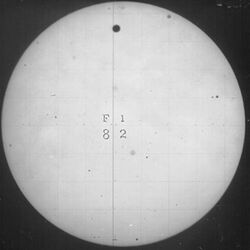Astronomy:Transit of Venus, 1882
The 1882 transit of Venus, which took place on 6 December 1882 (13:57 to 20:15 UTC), was the second and last transit of Venus of the 19th century, the first having taken place eight years earlier in 1874. Many an expedition was sent by European powers to describe both episodes, eight of them alone were approved and financed in 1882 by the United States Congress.[1]
Edward James Stone organized the British expeditions sent to observe the transit. Stephen Joseph Perry and Commander Pelham Aldrich, as captain of HMS Fawn, observed the transit from an improvised tent observatory in Madagascar .[2]
Jean-Charles Houzeau invented in 1871 a heliometer with unequal focal lengths. For the observation of the transit he organized two expeditions: one to San Antonio, Texas, and another to Santiago de Chile. The two expeditions each had an identical copy of Houzeau's heliometer.[3]
The French Academy of Sciences organized ten expeditions to various locations, including Florida, Mexico, Haiti, Martinique, and Cape Horn.[4] For observations of the transit by French expeditions, for the year 1883 the French Academy of Sciences awarded nine Lalande Prizes to scientists, including Jean Jacques Anatole Bouquet de La Grye (leader of expedition to Puebla, Mexico), Octave de Bernardières (leader of expedition to San Bernardo, Chile), and the naval officer Georges-Ernest Fleuriais (leader of expedition to the coast of the province Santa Cruz in Patagonia).[5][6]
References
- ↑ "The American Transit of Venus Expeditions of 1882, Including San Antonio". Aas.org. http://aas.org/archives/BAAS/v27n4/aas187/S035002.html. Retrieved 7 June 2014.
- ↑ Transits of Venus, 1874 & 1882, Royal Astronomical Society
- ↑ Sterken, Christiaan. "Jean-Charles Houzeau and the 1882 Belgian Transit of Venus Expeditions". http://www.vub.ac.be/STER/JAD/JAD19/jad19_1/jad19_1q.pdf.
- ↑ Passage de Vénus, Mission de Santa Cruz (Patagonie), Photograph Album, American Philosophical Society
- ↑ "LES LAURÉATS DU PRIX LALANDE". La Revue scientifique (Paris) TOME 40: 460–463. 1887. https://books.google.com/books?id=biIgAQAAMAAJ&pg=PA460.
- ↑ 1882 December 6, Venustransit, by Steven van Roode
External links




